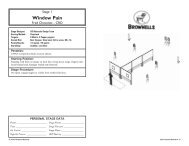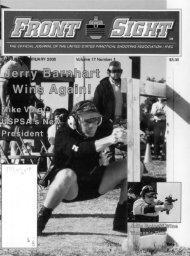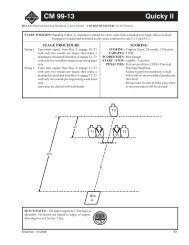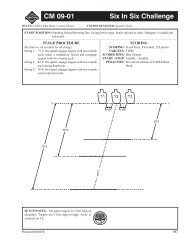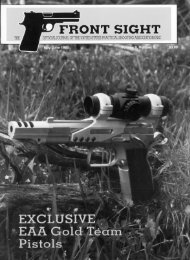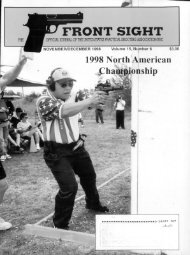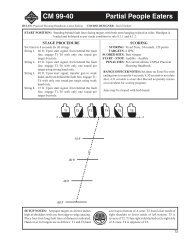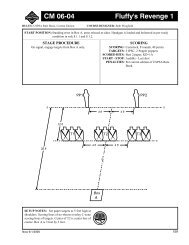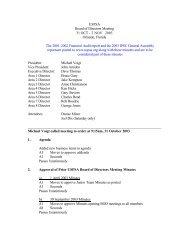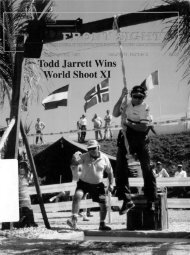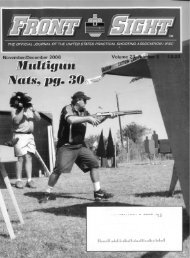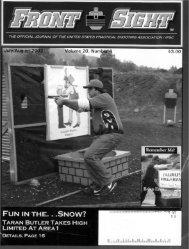Create successful ePaper yourself
Turn your PDF publications into a flip-book with our unique Google optimized e-Paper software.
1991 USPSA<br />
NATIONAL CHAMPIONSHIPS<br />
By: Kerby Smith A-2386<br />
Ever since Doug Koenig won<br />
the World Match with a high<br />
capacity electronic sighted pistol,<br />
it was no surprise that the top<br />
shooters would all be packing<br />
some form of "space gun" for this<br />
year's Nationals. The only<br />
question was, would the guns<br />
hold up for five days and 10<br />
stages of the best IPSC match<br />
in the country?<br />
The major factory teams,<br />
Colt, Smith & Wesson and<br />
Springfield Armory, had shooters<br />
using prototype pistols. Of<br />
the factory teams, Springfield<br />
Armory shooters Doug Koenig<br />
and Rob Leatham had the most<br />
mileage on their pistols and<br />
seemed to have worked out most<br />
of the problems with their P-9s<br />
ahead of the match. The weak<br />
link was the electronic sights.<br />
Leatham said before the match<br />
started that he would give $1000<br />
for a scope that could be counted<br />
on to last the raatch.<br />
Colt's Jerry Barnhart chose<br />
to use an unproven one-of-a-lcind<br />
Colt customized by Bill Wilson<br />
and George Heuning. The<br />
Wilson/Heuning effort had been<br />
to modify a traditional Colt<br />
G-overnment Model frame so<br />
that a double column CZ-75<br />
style magazine could be used.<br />
The pistol was chambered for<br />
the wildcat 9x21 cartridge and<br />
Barnhart could stuff 15 of the<br />
135-grain pills in the magazine.<br />
The only catch was that<br />
Barnhart received the high<br />
capacity pistol only a week and<br />
a half before the match.<br />
Convinced that he would need<br />
a high capacity gun to be<br />
competitive, Barnhart burned<br />
4,000 rounds through the pistol<br />
trying to get used to it before<br />
November/December 1991<br />
Tom Campbell — 1991 US National Stock<br />
Champion<br />
the Nationals.<br />
Team Smith & Wesson was<br />
running on the ragged edge as<br />
well. Brian Enos and J. Michael<br />
Plaxco ran out of time as they<br />
tried to make the new .356<br />
TS&W pistols work for this<br />
year's Nationals. The new<br />
truncated cone 135-grain bullet<br />
that Federal is using is one of<br />
the most accurate that Plaxco<br />
has ever seen. Unfortunately,<br />
when you try to race prototype<br />
guns and ammo you sometimes<br />
get behind the performance<br />
curve.<br />
Tom Campbell, who was off<br />
Team Smith & Wesson at The<br />
Masters, was back on the team<br />
at the USPSA Nationals.<br />
Campbell ground the grip<br />
weights out of his S&W .45 Aut,o<br />
so that it would make legal<br />
weight in the stock class.<br />
Campbell battled teammate<br />
Jerry Miculek, the defending<br />
USPSA National Stock and<br />
Ftevolver champion in the stock<br />
class. The two wound up<br />
splitting the honors with<br />
Campbell winning the U.S.<br />
National Stock Championship<br />
and Miculek winning the U.S.<br />
National Revolver<br />
Championship.<br />
Judy Woolley was feeling<br />
like the unwanted red-headed<br />
stepchild of Team Smith &<br />
Wesson when competitors asked<br />
if she was shooting one of the<br />
Performance Center pistols, and<br />
she had to tell them no.<br />
Woolley's gun was a S&W Model<br />
1006 which she purchased<br />
herself and had fitted with a Wil<br />
Schuemann Hybrid<br />
Compensator. Woolley was<br />
shooting the lOmm Auto<br />
exceptionally well until she<br />
injured herself going prone on<br />
Stage 10, "The Streets of<br />
Khafji." Woolley injured her<br />
strongside elbow going too<br />
aggressively into the sandbags<br />
at position B and had trouble<br />
shooting her next stage, the<br />
Standards, which accounted for<br />
over 17 percent of the match<br />
points in the tournament.<br />
Woolley finished fifth among the<br />
42 ladies that shot this year's<br />
U.S. Nationals.<br />
It looked like this year's<br />
Nationals was going to resemble<br />
more of an. endurance race than<br />
a grand prix. The winner was<br />
not going to be the fastest<br />
shooter, but the one whose gun<br />
was still functioning at the end<br />
of the race.<br />
Whether the guns held up<br />
or not, it was evident from the<br />
firing of the first shot that no<br />
one was going to back off the<br />
throttle. Last year the Super<br />
Squad finished up on the<br />
notorious computer stage ''House<br />
(Continued on page 14)<br />
Page 13



